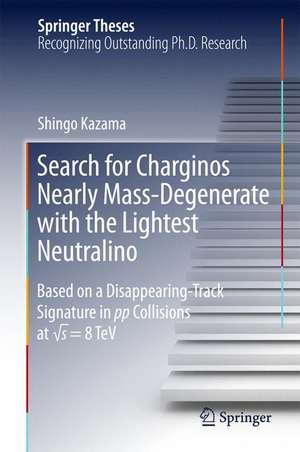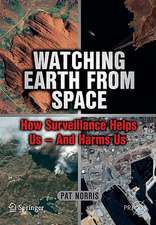Search for Charginos Nearly Mass-Degenerate with the Lightest Neutralino: Based on a Disappearing-Track Signature in pp Collisions at √s = 8 TeV: Springer Theses
Autor Shingo Kazamaen Limba Engleză Hardback – 30 oct 2015
The author develops a new method, called “re-tracking,” to detect charged winos that decay before reaching the Semiconductor Tracker (SCT) detector. Because the nominal tracking algorithm at the ATLAS experiment requires at least seven successive hits in the inner tracking system, the sensitivity to charged winos having a fraction of a nanosecond in the past analysis was therefore limited. However, re-tracking requires a minimum of three pixel hits and provides a fully efficient tracking capability for charged winos traversing the pixel detector, resulting in around about 100 times greater efficiency for charged winos with a lifetime ~0.2 ns longer than that in past searches.
Signal topology is characterized by a jet with large transverse momentum (pT), large missing transverse energy, and a high-pT disappearing track. There are three types of back
ground tracks: interacting hadron tracks, charged leptons, and tracks with mismeasured pT. A background estimation based on the Monte Carlo (MC) simulation suffers from large uncertainties due to poor statistics and has difficulty simulating the properties of background tracks. Therefore, a data-driven approach has been developed by the author of the book to estimate the background track-pT spectrum. No significant excess above the background expectation is observed for candidate tracks with large transverse momentum, and constraints on the AMSB model are obtained. The author shows that in the AMSB model, a charged wino mass below 270 GeV is excluded at 95 % confidence level, which also directly constrains the mass of wino dark matter.
| Toate formatele și edițiile | Preț | Express |
|---|---|---|
| Paperback (1) | 634.00 lei 6-8 săpt. | |
| Springer – 23 aug 2016 | 634.00 lei 6-8 săpt. | |
| Hardback (1) | 641.85 lei 3-5 săpt. | |
| Springer – 30 oct 2015 | 641.85 lei 3-5 săpt. |
Din seria Springer Theses
- 18%
 Preț: 997.88 lei
Preț: 997.88 lei -
 Preț: 389.88 lei
Preț: 389.88 lei - 15%
 Preț: 646.94 lei
Preț: 646.94 lei - 18%
 Preț: 943.43 lei
Preț: 943.43 lei -
 Preț: 399.29 lei
Preț: 399.29 lei - 18%
 Preț: 944.99 lei
Preț: 944.99 lei - 15%
 Preț: 636.80 lei
Preț: 636.80 lei - 18%
 Preț: 941.05 lei
Preț: 941.05 lei - 15%
 Preț: 643.16 lei
Preț: 643.16 lei - 15%
 Preț: 642.68 lei
Preț: 642.68 lei - 18%
 Preț: 1103.62 lei
Preț: 1103.62 lei - 20%
 Preț: 558.82 lei
Preț: 558.82 lei - 18%
 Preț: 1112.30 lei
Preț: 1112.30 lei - 18%
 Preț: 944.19 lei
Preț: 944.19 lei - 18%
 Preț: 1109.92 lei
Preț: 1109.92 lei - 18%
 Preț: 1217.27 lei
Preț: 1217.27 lei - 15%
 Preț: 640.06 lei
Preț: 640.06 lei - 15%
 Preț: 636.45 lei
Preț: 636.45 lei - 15%
 Preț: 640.06 lei
Preț: 640.06 lei - 15%
 Preț: 640.88 lei
Preț: 640.88 lei -
 Preț: 389.70 lei
Preț: 389.70 lei - 20%
 Preț: 563.89 lei
Preț: 563.89 lei -
 Preț: 393.35 lei
Preț: 393.35 lei - 15%
 Preț: 637.93 lei
Preț: 637.93 lei - 18%
 Preț: 1225.94 lei
Preț: 1225.94 lei - 20%
 Preț: 551.36 lei
Preț: 551.36 lei - 18%
 Preț: 1229.10 lei
Preț: 1229.10 lei - 15%
 Preț: 639.25 lei
Preț: 639.25 lei - 18%
 Preț: 999.45 lei
Preț: 999.45 lei - 15%
 Preț: 640.06 lei
Preț: 640.06 lei - 18%
 Preț: 1220.45 lei
Preț: 1220.45 lei - 18%
 Preț: 1116.26 lei
Preț: 1116.26 lei - 18%
 Preț: 1110.72 lei
Preț: 1110.72 lei - 18%
 Preț: 1000.87 lei
Preț: 1000.87 lei - 18%
 Preț: 891.17 lei
Preț: 891.17 lei - 15%
 Preț: 640.06 lei
Preț: 640.06 lei - 5%
 Preț: 1154.07 lei
Preț: 1154.07 lei - 15%
 Preț: 635.96 lei
Preț: 635.96 lei - 15%
 Preț: 640.88 lei
Preț: 640.88 lei -
 Preț: 387.20 lei
Preț: 387.20 lei - 18%
 Preț: 1109.92 lei
Preț: 1109.92 lei -
 Preț: 385.25 lei
Preț: 385.25 lei -
 Preț: 385.25 lei
Preț: 385.25 lei - 18%
 Preț: 1112.30 lei
Preț: 1112.30 lei - 18%
 Preț: 999.45 lei
Preț: 999.45 lei -
 Preț: 386.99 lei
Preț: 386.99 lei - 15%
 Preț: 637.13 lei
Preț: 637.13 lei - 20%
 Preț: 554.20 lei
Preț: 554.20 lei - 20%
 Preț: 555.57 lei
Preț: 555.57 lei
Preț: 641.85 lei
Preț vechi: 755.13 lei
-15% Nou
Puncte Express: 963
Preț estimativ în valută:
122.81€ • 128.23$ • 101.65£
122.81€ • 128.23$ • 101.65£
Carte disponibilă
Livrare economică 15-29 martie
Preluare comenzi: 021 569.72.76
Specificații
ISBN-13: 9784431556565
ISBN-10: 4431556567
Pagini: 148
Ilustrații: XIII, 148 p.
Dimensiuni: 155 x 235 x 17 mm
Greutate: 0.46 kg
Ediția:1st ed. 2016
Editura: Springer
Colecția Springer
Seria Springer Theses
Locul publicării:Tokyo, Japan
ISBN-10: 4431556567
Pagini: 148
Ilustrații: XIII, 148 p.
Dimensiuni: 155 x 235 x 17 mm
Greutate: 0.46 kg
Ediția:1st ed. 2016
Editura: Springer
Colecția Springer
Seria Springer Theses
Locul publicării:Tokyo, Japan
Public țintă
ResearchCuprins
Introduction.- Theoretical Framework and Motivation.- LHC and ATLAS Detector.- Data and Monte Carlo Simulation.- Object Reconstruction.- Tracking Performance.- Properties of Signal Events.- Event Selection.- Background Estimation.- Systematic Uncertainties.- Extraction of Signal Yield .- Interpretations and Discussion.- Conclusions.
Textul de pe ultima copertă
In this book, the anomaly mediated supersymmetry breaking (AMSB) model is explored by searching for charged winos with their subsequent decays collected with the ATLAS detector at the Large Hadron Collider (LHC).
The author develops a new method, called “re-tracking,” to detect charged winos that decay before reaching the Semiconductor Tracker (SCT) detector. Because the nominal tracking algorithm at the ATLAS experiment requires at least seven successive hits in the inner tracking system, the sensitivity to charged winos having a fraction of a nanosecond in the past analysis was therefore limited. However, re-tracking requires a minimum of three pixel hits and provides a fully efficient tracking capability for charged winos traversing the pixel detector, resulting in around about 100 times greater efficiency for charged winos with a lifetime ~0.2 ns longer than that in past searches.
Signal topology is characterized by a jet with large transverse momentum (pT), large missing transverse energy, and a high-pT disappearing track. There are three types of background tracks: interacting hadron trac
ks, charged leptons, and tracks with mismeasured pT. A background estimation based on the Monte Carlo (MC) simulation suffers from large uncertainties due to poor statistics and has difficulty simulating the properties of background tracks. Therefore, a data-driven approach has been developed by the author of the book to estimate the background track-pT spectrum. No significant excess above the background expectation is observed for candidate tracks with large transverse momentum, and constraints on the AMSB model are obtained. The author shows that in the AMSB model, a charged wino mass below 270 GeV is excluded at 95 % confidence level, which also directly constrains the mass of wino dark matter.
The author develops a new method, called “re-tracking,” to detect charged winos that decay before reaching the Semiconductor Tracker (SCT) detector. Because the nominal tracking algorithm at the ATLAS experiment requires at least seven successive hits in the inner tracking system, the sensitivity to charged winos having a fraction of a nanosecond in the past analysis was therefore limited. However, re-tracking requires a minimum of three pixel hits and provides a fully efficient tracking capability for charged winos traversing the pixel detector, resulting in around about 100 times greater efficiency for charged winos with a lifetime ~0.2 ns longer than that in past searches.
Signal topology is characterized by a jet with large transverse momentum (pT), large missing transverse energy, and a high-pT disappearing track. There are three types of background tracks: interacting hadron trac
ks, charged leptons, and tracks with mismeasured pT. A background estimation based on the Monte Carlo (MC) simulation suffers from large uncertainties due to poor statistics and has difficulty simulating the properties of background tracks. Therefore, a data-driven approach has been developed by the author of the book to estimate the background track-pT spectrum. No significant excess above the background expectation is observed for candidate tracks with large transverse momentum, and constraints on the AMSB model are obtained. The author shows that in the AMSB model, a charged wino mass below 270 GeV is excluded at 95 % confidence level, which also directly constrains the mass of wino dark matter.
Caracteristici
Nominated as an outstanding contribution by the University of Tokyo's Physics Department in 2014 Describes the search for long-lived massive particles based on a disappearing-track signature Covers a new tracking algorithm to enhance a track reconstruction efficiency for charged winos having short decay length Explores supersymmetric models with the pure neutral wino being the LSP, which are motivated by the property measurements of the Higgs boson at the LHC Includes supplementary material: sn.pub/extras




